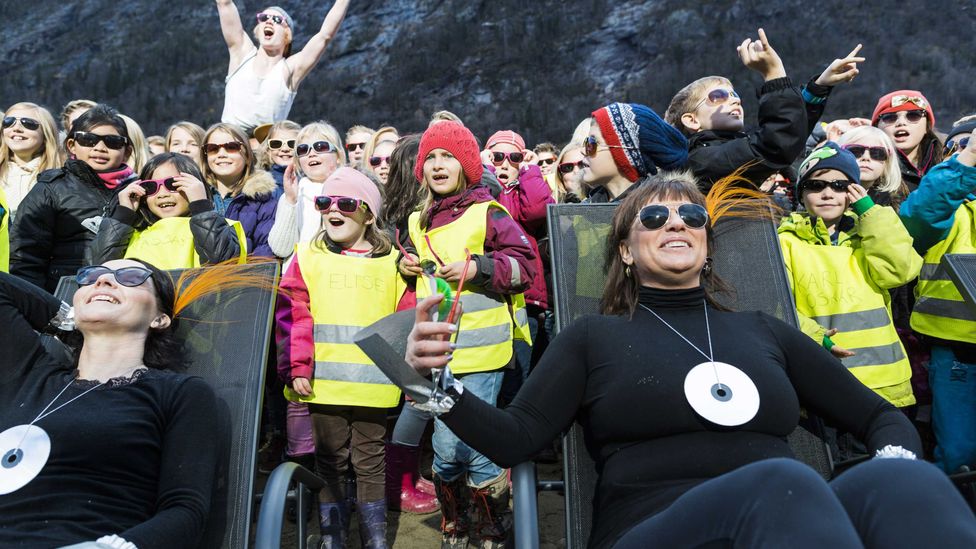
People cheer during an inauguration of the Sun mirrors (Credit: Krister Soerboe/AFP/Getty Images)
Article continues below
The inhabitants of Rjukan in southern Norway have a complex relationship with the Sun. “More than other places I’ve lived, they like to talk about the Sun: when it’s coming back, if it’s a long time since they’ve seen the Sun,” says artist Martin Andersen. “They’re a little obsessed with it.” Possibly, he speculates, it’s because for approximately half the year, you can see the sunlight shining high up on the north wall of the valley: “It is very close, but you can’t touch it,” he says. As autumn wears on, the light moves higher up the wall each day, like a calendar marking off the dates to the winter solstice. And then as January, February and March progress, the sunlight slowly starts to inch its way back down again.
Rjukan was built between 1905 and 1916, after an entrepreneur called Sam Eyde bought the local waterfall (known as the smoking waterfall) and constructed a hydroelectric power plant there. Factories producing artificial fertiliser followed. But the managers of these factories worried that their staff weren’t getting enough Sun – and eventually they constructed a cable car in order to give them access to it.
When Martin moved to Rjukan in August 2002, he was simply looking for a temporary place to settle with his young family that was close to his parents’ house and where he could earn some money. He was drawn to the three-dimensionality of the place: a town of 3,000, in the cleft between two towering mountains – the first seriously high ground you reach as you travel west of Oslo.
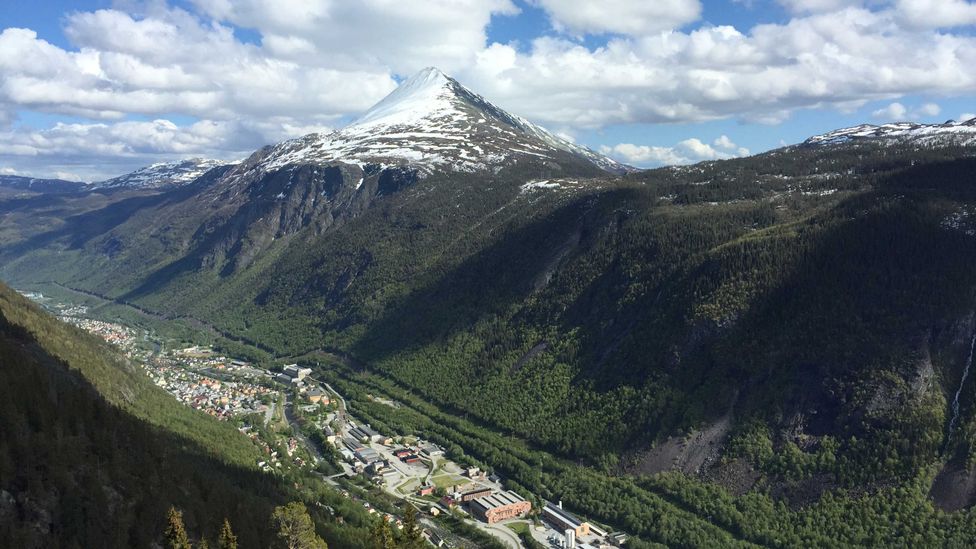
Rjukan sits at the base of a valley in in southern Norway (Credit: Olav Gjerstad/Flickr/CC BY 2.0)
I felt it very physically; I didn’t want to be in the shade – Martin Andersen
But the departing Sun left Martin feeling gloomy and lethargic. It still rose and set each day, and provided some daylight – unlike in the far north of Norway, where it is dark for months at a time – but the Sun never climbed high enough for the people of Rjukan to actually see it or feel its warming rays directly on their skin.
As summer turned to autumn, Martin found himself pushing his two-year-old daughter’s buggy further and further down the valley each day, chasing the vanishing sunlight. “I felt it very physically; I didn’t want to be in the shade,” says Martin, who runs a vintage shop in Rjukan town centre. If only someone could find a way of reflecting some sunlight down into the town, he thought. Most people living at temperate latitudes will be familiar with Martin’s sense of dismay at autumn’s dwindling light. Few would have been driven to build giant mirrors above their town to fix it.
Dark place
What is it about the flat, gloomy greyness of winter that seems to penetrate our skin and dampen our spirits, at least at higher latitudes? The idea that our physical and mental health varies with the seasons and sunlight goes back a long way. The Yellow Emperor’s Classic of Medicine, a treatise on health and disease that’s estimated to have been written in around 300 BCE, describes how the seasons affect all living things. It suggests that during winter – a time of conservation and storage – one should “retire early and get up with the sunrise... Desires and mental activity should be kept quiet and subdued, as if keeping a happy secret.” And in his Treatise on Insanity, published in 1806, the French physician Philippe Pinel noted a mental deterioration in some of his psychiatric patients “when the cold weather of December and January set in”.
Why should darker months trigger this tiredness and low mood in so many people?
Today, this mild form of malaise is often called the winter blues. And for a minority of people who suffer from seasonal affective disorder (SAD), winter is quite literally depressing. First described in the 1980s, the syndrome is characterised by recurrent depressions that occur annually at the same time each year.
Even healthy people who have no seasonal problems seem to experience this low-amplitude change over the year, with worse mood and energy during autumn and winter and an improvement in spring and summer.
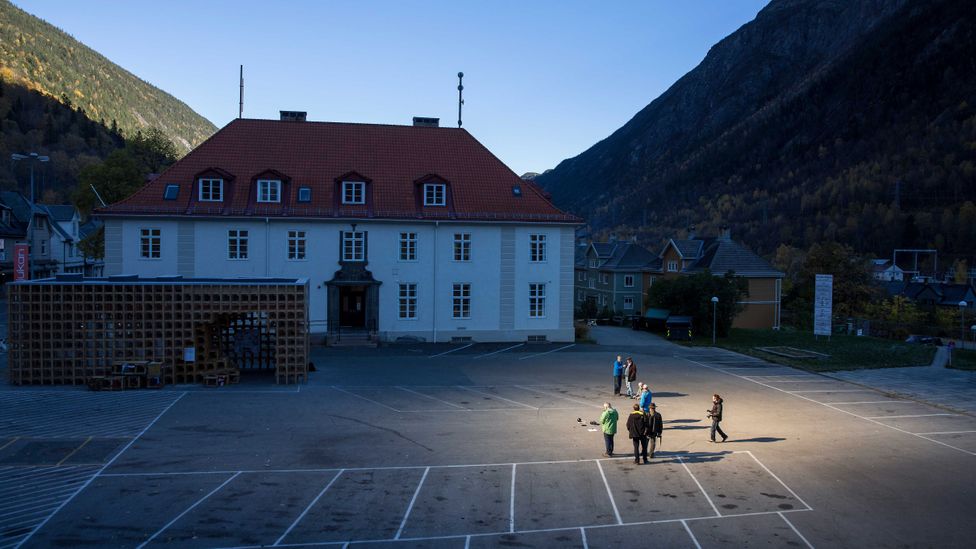
The light shines on the town square but not the rest of Rjukan (Credit: Getty Images)
Why should darker months trigger this tiredness and low mood in so many people? There are several theories, none of them definitive, but most relate to the circadian clock. One idea is that some people’s eyes are less sensitive to light, so once light levels fall below a certain threshold, they struggle to synchronise their circadian clock with the outside world. Another is that some people produce more of a hormone called melatonin during winter than in summer.
However, the leading theory is the ‘phase-shift hypothesis’: the idea that shortened days cause the timing of our circadian rhythms to fall out of sync with the actual time of day, because of a delay in therelease of melatonin. Levels of this hormone usually rise at night in response to darkness, helping us to feel sleepy, and are suppressed by the bright light of morning. “If someone’s biological clock is running slow and that melatonin rhythm hasn’t fallen, then their clock is telling them to keep on sleeping even though their alarm may be going off and life is demanding that they wake up,” says Kelly Rohan, a professor of psychology at the University of Vermont. Precisely why this should trigger feelings of depression is still unclear. One idea is that this tiredness could then have unhealthy knock-on effects. If you’re having negative thoughts about how tired you are, this could trigger a sad mood, loss of interest in food, and other symptoms that could cascade on top of that.
However, recent insights into how birds and small mammals respond to changes in day length have prompted an alternative explanation. According to Daniel Kripke, an emeritus professor of psychiatry at the University of California, San Diego, when melatonin strikes a region of the brain called the hypothalamus, this alters the synthesis of another hormone – active thyroid hormone – that regulates all sorts of behaviours and bodily processes.
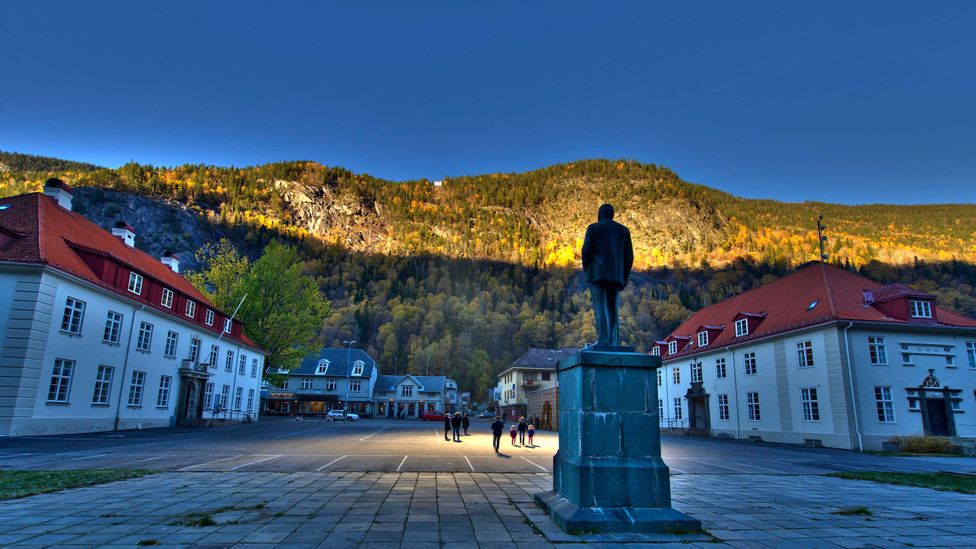
For approximately half the year, you can see the sunlight shining high up on the north wall of the valley above Rjukan (Credit: Bilfinger SE/Flickr/CC BY 2.0)
When dawn comes later in the winter, the end of melatonin secretion drifts later, says Kripke. From animal studies, it appears that high melatonin levels just after the time an animal wakes up strongly suppress the making of active thyroid hormone – and lowering thyroid levels in the brain can cause changes in mood, appetite and energy. For instance, thyroid hormone is known to influence serotonin, a neurotransmitter that regulates mood. Several studies have shown that levels of brain serotonin in humans are at their lowest in the winter and highest in the summer.
It’s possible that many of these mechanisms are at work, even if the precise relationships haven’t been fully teased apart yet. But regardless of what causes winter depression, bright light – particularly when delivered in the early morning – seems to reverse the symptoms.
Mirror, mirror
It was a bookkeeper called Oscar Kittilsen who first came up with the idea of erecting large rotatable mirrors on the northern side of the valley above Rjukan, where they would be able to “first collect the sunlight and then spread it like a headlamp beam over the town and its merry inhabitants”.
A month later, on 28 November 1913, a newspaper story described Sam Eyde pushing the same idea, although it was another hundred years before it was realised. Instead, in 1928, Norsk Hydro erected a cable car as a gift to the townspeople, so that they could get high enough to soak up some sunlight in winter. Instead of bringing the Sun to the people, the people would be brought to the sunshine.
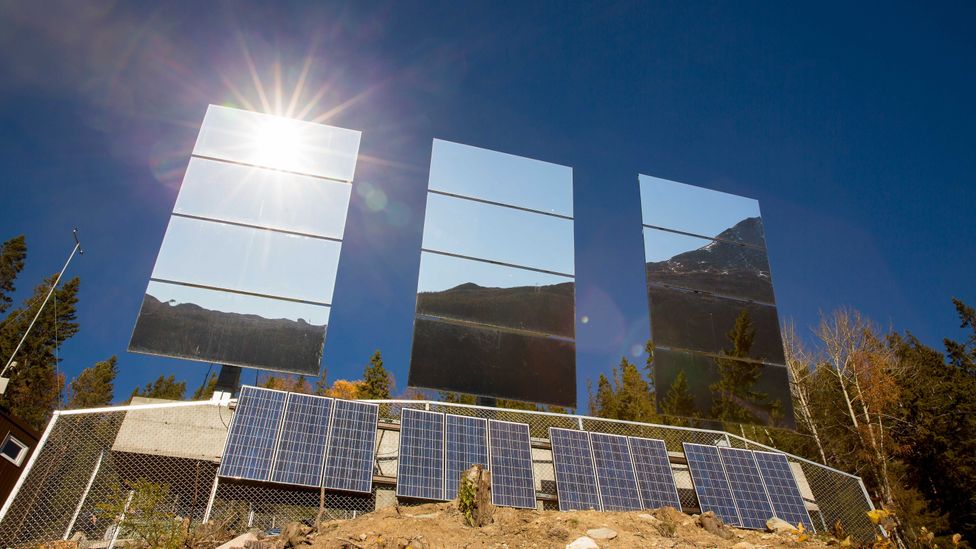
The mirrors are mounted in such a way that they turn to keep track of the Sun (Credit: Getty Images)
Martin Andersen didn’t know all of this. But after receiving a small grant from the local council to develop the idea, he learned about this history and started to develop some concrete plans. These involved a heliostat: a mirror mounted in such a way that it turns to keep track of the Sun while continually reflecting its light down towards a set target – in this case, Rjukan town square.
The three mirrors stand proud upon the mountainside
The three mirrors, each measuring 17 sq m, stand proud upon the mountainside above the town. In January, the Sun is only high enough to bring light to the square for two hours per day, from midday until 2pm, but the beam produced by the mirrors is golden and welcoming. Stepping into the sunlight after hours in permanent shade, I become aware of just how much it shapes our perception of the world. Suddenly, things seem more three-dimensional; I feel transformed into one of those ‘merry inhabitants’ that Kittilsen imagined. When I leave the sunlight, Rjukan feels a flatter, greyer place.
Not everyone in Rjukan has welcomed the Sun mirrors with open arms. Many of the locals I spoke to dismissed them as a tourist gimmick – though all admitted they were good for business. On the day I visited, the town was blessed with clear blue skies and a golden shaft of light descending from the mirrors, yet few people lingered in the town square. In fact, of the people I spoke to, it was recent immigrants to Rjukan who seemed most appreciative of the mirrors.

People cheer during an inauguration of the Sun mirrors (Credit: Krister Soerboe/AFP/Getty Images)
Andersen admits to having got used to the lack of sunlight over time. “I don’t find it so bad anymore,” he says. It’s as though the people who’ve been brought up in this uniquely shady place, or who have chosen to stay, have grown immune to the normal thirst for sunlight.
This is certainly the case in another Norwegian settlement: Tromso. One of the world’s most northerly cities, it is some 400km north of the Arctic Circle. Winter in Tromso is dark – the Sun doesn’t even rise above the horizon between 21 November and 21 January. Yet strangely, despite its high latitude, studies have found no difference between rates of mental distress in winter and summer.
One suggestion is that this apparent resistance to winter depression is genetic. Iceland similarly seems to buck the trend for SAD: it has a reported prevalence of 3.8%, which is lower than that of many countries farther south. And among Canadians of Icelandic descent living in the Canadian province Manitoba, the prevalence of SAD is approximately half that of non-Icelandic Canadians living in the same place.
Some people have an apparent resistance to winter depression – why?
However, an alternative explanation for this apparent resilience in the face of darkness is culture. “To put it brutally and brief: it seems like there are two sorts of people who come up here,” says Joar Vitterso, a happiness researcher at the University of Tromso. “One group tries to get another kind of work back down south as soon as possible; the other group remains.”
Ane-Marie Hektoen grew up in Lillehammer in southern Norway, but moved to Tromso 33 years ago with her husband, who grew up in the north. “At first I found the darkness very depressing; I was unprepared for it, and after a few years I needed to get a light box in order to overcome some of the difficulties,” she says. “But over time, I have changed my attitude to the dark period. People living here see it as a cosy time. In the south the winter is something that you have to plough through, but up here people appreciate the very different kind of light you get at this time of year.”
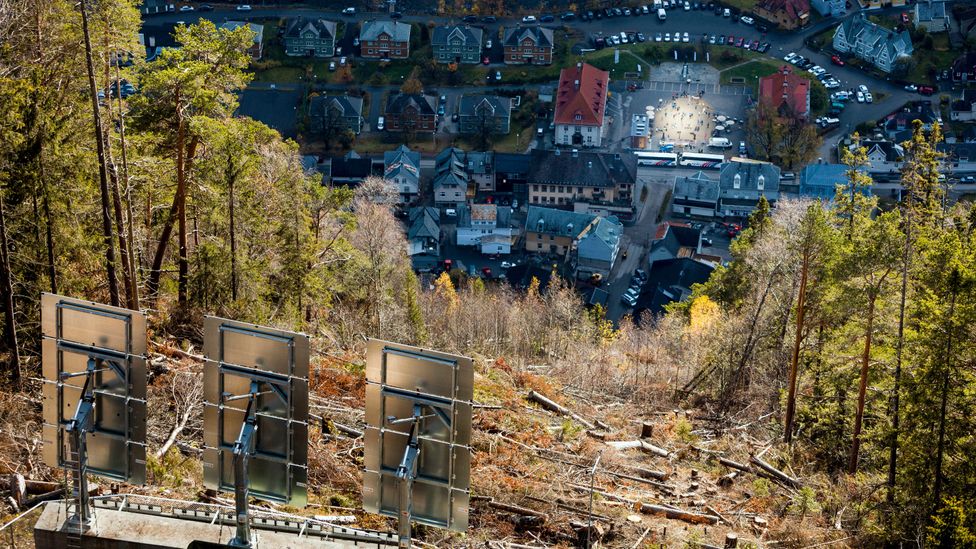
Looking down on Rjukan, the path of the reflected sunlight (Credit: Krister Soerboe/AFP/Getty Images)
Stepping into Hektoen’s house is like being transported into a fairy-tale version of winter. There are few overhead lights, and those that do exist drip with crystals, which bounce the light around. The breakfast table is set with candles, and the interior is furnished in pastel pinks, blues and white, echoing the soft colours of the snow and the winter sky outside. It is the epitome of kos or koselig – the Norwegian version of hygge, the Danish feeling of warmth and cosiness.
The period between 21 November and 21 January in Tromso is known as the polar night, or dark period, but for at least several hours a day it isn’t strictly speaking dark, but more of a soft twilight. Even when true darkness does descend, people stay active. One afternoon I hire a pair of cross-country skis and set off down one of the street-lit tracks that criss-cross the edge of the city. Despite the darkness, I encounter people taking dogs for walks on skis, a man running with a head torch, and countless children having fun on sledges. I stop at a park and marvel at a children’s playground lit up by floodlights. “Do children climb here in winter?” I ask a young woman, who is struggling to pull on a pair of ice skates. “Of course,” she answers. “It’s why we have floodlights. If we didn’t, we’d never get anything done.”
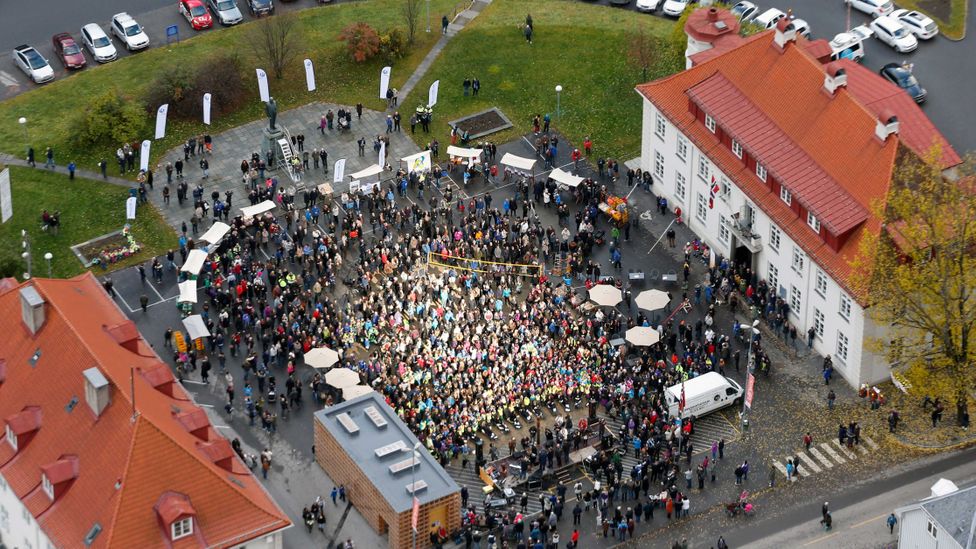
Residents gather to enjoy the light (Credit: Getty Images)
It sounds dismissively simple, but a more positive attitude really might help to ward off the winter blues
During 2014-15, a psychologist from Stanford University called Kari Leibowitz spent 10 months in Tromso trying to figure out how people cope during the cold, dark winters. Together with Vitterso, she devised a ‘winter mindset questionnaire’ to assess people’s attitudes to winter in Tromso, the Svalbard archipelago and the Oslo area. The farther north they went, the more positive people’s mindsets towards winter were, she tells me. “In the south, people didn’t like winter nearly as much. But across the board, liking winter was associated with greater life satisfaction and being willing to undertake challenges that lead to greater personal growth.”
It sounds dismissively simple, but adopting a more positive attitude really might help to ward off the winter blues. Kelly Rohan recently published a clinical trial comparing cognitive behavioural therapy (CBT) to light therapy in the treatment of SAD, and found them comparable during the first year of treatment. CBT involves learning to identify patterns and errors in one’s way of thinking and challenging them. In the case of SAD, that could be rephrasing thoughts such as ‘I hate winter’ to ‘I prefer summer to winter’, or ‘I can’t do anything in winter’ to ‘It’s harder for me to do things in winter, but if I plan and put in effort I can’.
It also involves finding activities that a person is willing to do in winter, to pull them out of hibernation mode. “I don’t argue that there isn’t a strong physiological component to seasonal depression, which is tied to the light-dark cycle,” says Rohan. “But I do argue that the person has some control over how they respond to and cope with that. You can change your thinking and behaviour to feel a bit better at this time of year.”
This is an edited version of an article first published by Wellcome on Mosaic and is republished here under a Creative Commons licence. Visit Mosaic to read the longer version, which also describes how artificial light can regulate mood.
==================================================================
why not permanent space reflectors TO LIGHT STREETS AT NIGHT?
TO LIGHT EARTH AT NIGHT ?
Space mirror "illumines" Europe by night
A Russian attempt to light up the night by using sunlight reflected from a huge space-based mirror failed to come up to expectations but could some day provide an alternative to electric lighting.
Published: Thursday 15 April 1993
 WHILE it was still dark on a recent February night, a swath of light streaked across Europe for a few moments, telling the world that brightness at midnight had become a reality.
WHILE it was still dark on a recent February night, a swath of light streaked across Europe for a few moments, telling the world that brightness at midnight had become a reality.
For six minutes beginning 0522 GMT (1052 AM in India) on February 4, sunlight reflected by a space-based, circular mirror sped rapidly from Lyons in France to Brest in Belarus. Made of Kevlar -- a tough material also used in making bullet-proof vests -- and thinner than a human hair, the 20-metre mirror was unfurled from an unmanned Russian supply spacecraft alongside the Mir space station.
Russian scientists had claimed the mirror would be "as bright as several full moons" and would illuminate people in the streets "like actors on the stage". But in southern France, the mirror was visible only as a bright spot and its ground illumination was much less than ordinary moonlight.
The experiment, supported by the Russian space company, Energiya, was intended to show that mirrors deployed in space could save vast amounts of electricity by providing solar light to regions where winter night can last for months. The experiment also sought to show reflected sunlight could help in rescue operations after natural disasters like earthquakes and hurricanes that disrupt local power supply.
However, the experiment seems to have upset astronomers. Peter Andrews of UK's Royal Greenwich Observatory explained that light reflected by ordinary mirrors, howsoever faint, would interfere with observations through telescopes. Paul Murdin, who heads an International Astronomical Union panel on observatory protection, said safeguards would have to be taken to protect delicate instruments if the Russians expand their space mirror project.
However, observers predict there is little likelihood of Energiya continuing with the project because it is running out of money. Viktor Blagov, director of the Russian space flight control centre at Kaliningrad, said, "We need to collect money to continue the programme."
Clearly, the Russians have miles to go before their space mirrors can turn night into day.
Russians to Test Space Mirror As Giant Night Light for Earth

RUSSIAN scientists are planning soon to unfurl a glistening sheet of plastic in space as a first step toward testing an intriguing notion about turning night into day -- or at least twilight.
Tucked aboard a Progress cargo spacecraft attached to the Mir space station is an experiment called Znamya, or Banner, that will test the idea of using a mirror in space to reflect sunlight down to Earth.
If all goes as planned, the Banner payload will be deployed next month to unfurl into a 65-foot-diameter disk of aluminum-coated plastic film. The experiment will test the feasibility of illuminating points on Earth with light equivalent to that of several full moons.
Russian engineers say it should also teach them a lot about handling thin sheets of plastic in space, a step toward developing large sails to propel ships in space using the faint force of sunlight.
"This should be a marvelous technical demonstration," said James E. Oberg of Houston, an expert on Russian space programs who wrote the book "Red Star in Orbit."
"It's an idea they've talked about for a long time, and now they will have a chance to see if it works."
The Sun is always shining somewhere on Earth, of course, if not always where people need or want it. But what if someone put a big reflector high in space to peer over the curvature of Earth, capture some of the Sun's rays and shine them down on the dark side?
In much the way a schoolchild playing with a hand mirror learns to reflect a spot of light from a bright window into the crannies of his room, some scientists believe they can put large, orbiting mirrors above Earth that could illuminate darkened areas below with spots of reflected sunlight that measure tens of miles across.
If it can be done, proponents say, providing sunshine at night could save billions of dollars each year in electrical lighting costs, extend twilight hours during planting and harvesting seasons to aid farmers, allow more working hours on large construction projects and help in rescue and recovery operations after natural disasters like earthquakes and hurricanes.
A consortium of state-owned companies and agencies in Russia, headed by the NPO Energia space company, is sponsoring the mirror-solar sail demonstration. The project is using some donated equipment, and engineers and technicians are volunteering their time. Proponents of the project hope a successful test will attract financial support from Western companies and the Russian Government.
The idea of using mirrors in space like giant spotlights was proposed in 1929 by Hermann Oberth, a German scientist and space visionary. The idea was further developed by scientists in the United States and in the former Soviet Union, where it remains particularly popular because of its potential usefulness for lighting northern Siberia and other areas near the Arctic Circle during the long polar nights.
Although both the Pentagon and the National Aeronautics and Space Administration considered solar reflectors from time to time in the last two decades, they never developed them. Ambitious Goals
But Russian theorists have eagerly proposed solar reflector systems that could constantly illuminate areas the size of several cities every night. The most ambitious proposal foresees a constellation of 100 reflectors, each 1,300 feet in diameter with a surface area of 30 acres.
Initial operational systems, using reflectors 650 feet in diameter, would have 24 to 36 mirrors in northern inclination orbits either 620 miles or 3,700 miles above Earth, proponents say. A reflector could light a spot by itself or several could be focused on the same area for continuous illumination or greater brightness, scientists say, producing the light of up to 50 full moons. These mirrors, which would pivot as they passed overhead to keep their light on the same spot, could illuminate surface areas 35 miles to 55 miles across.
While the idea of space mirrors fascinates some, others have wondered about possible environmental effects of interrupting the normal day-night cycle of animals and plants, particularly if the practice became widespread.
Even extended daylight would affect the development and behavior of flora and fauna, and might influence local weather. After Soviet scientists first proposed launching a demonstration reflector satellite in 1984, the Soviet Academy of Sciences set up a committee to investigate possible ecological effects.
Proponents of space mirrors say there is no evidence to date that reflected sunlight would cause harm, but agree on the need for environmental studies. Light from space would be both clean and renewable, they note, and would replace generated electricity and its associated pollution.
"Illumination of this type will not have an impact on local environmental conditions, such as warming of the atmosphere," said Nikolay N. Sevastianov, director general of the experimental reflector program, which has been named Noviy Svet, or New Light.
"Other possible impacts to the environment are being studied and are part of the on-going project," he said in a written response to questions sent to him in Moscow. Resistance to Change
Dr. Roald Sagdeev, former director of the Soviet Academy of Science's Space Science Institute and now director of the East-West Science and Technology Center at the University of Maryland in College Park, said advocates of a Soviet space mirror began promoting the idea 15 years ago. But authorities in the space program were skeptical, he said, because the benefits were uncertain.
"While some people would be happy with light from space, others might not like it," Dr. Sagdeev said in an interview. "In all of the dark areas of the sub-Arctic, people have adapted to the natural cycles they have and may not want it to change."
The mirror proposal faces technical hurdles, like developing a pointing system that can keep a spot of light trained on a specific area of the ground as the reflector travels through space at almost 18,000 miles an hour, Dr. Sagdeev said. But he added that it probably could be made to work. "Technically, you could put up a big mirror," he said, "but the issue is finding a use for it."
Space mirror proponents say successful tests with Banner and similar future spacecraft will prove the concept and its usefulness.
The Progress spacecraft carrying the 88-pound Banner experiment as a secondary payload docked with the Mir space station on Oct. 30. The reflector was to have been deployed in December, but Russian space authorities delayed it because of the upcoming linkup to Mir of a Soyuz-TM spacecraft. The Soyuz will test a new docking system that an American space shuttle will use to hook up with Mir in 1995. Planners decided to leave the Progress in place to keep the space station balanced during the Soyuz test.
Plans now call for the Mir astronauts to fit the drum containing Banner into the docking port of the Progress before the unmanned supply ship leaves the station on Feb. 4 or 5. When the Progress is 500 feet from Mir, Banner is to be deployed by an electric motor that spins its drum and unfolds the eight-segment reflector disk like a Japanese fan. The mirror will orbit at an altitude of about 225 miles, and from Earth will look like a bright star . Light of Three Moons
The plastic reflector has no support frame and its circular shape is to be maintained by the rotation of the drum, its designers say. Dropping to a lower orbit than Mir, Progress will sue maneuvering thrusters to point and position the mirror to reflect sunlight to specific spots on Earth. After three to five days of tests, both Banner and Progress will re-enter the atmosphere and burn up.
During the tests, Russian engineers say the small reflector should cast light equivalent to three to five full moons over an area of Earth measuring about three miles in diameter. They hope the astronauts will be able to see and photograph the spot as it moves across the night side of the planet.
Vladimir S. Syromiatnikov, the mission manager for NPO Energia, said the reflected light from this simple test should move over the ground swiftly, visible to observers as a brief flash. In the sky, Banner should look like a bright star to those within the beam of light, and under certain conditions, he said, this artificial star might be visible in the daytime.
The test is also drawing attention worldwide from engineers and space enthusiasts who are interested in the concept of solar sailing, in which gossamer sails hundreds or thousands of feet long and wide would harness the pervasive pressure of sunlight in the vacuum of space to move ships.
Studies by NASA and others indicate that solar sailing is a feasible way of propulsion that would free spacecraft from having to carry heavy chemical fuel. But like the space reflector idea, no government has supported the concept with money to test it. For years, private groups in the United States, Russia, Japan and Europe have proposed an international race to the Moon using different kinds of sails. But the effort remains Earthbound because of a lack of funds. First Test of Solar Sail
"A lot of people are excited about the Russian test because it will mark the first time a solar sail is deployed," said Dr. Louis D. Friedman, executive director of the Planetary Society, a national public membership organization in Pasadena, Calif., that promotes space exploration.
Dr. Friedman, who headed a major NASA study of solar sailing in the mid-1970's, said both reflectors and sails used the same materials and principles. While the Banner test is too short and too low in the atmosphere to test solar-sail flight, it should be a good test of deployment and material handling.
"There is only so much testing and modeling that you can do on Earth, because you really can't answer some questions unless you go into space," Dr. Friedman said in an interview. "I'm jealous. It's a neat test and I wish we were doing it."
But the ambitious plan still wouldn’t “light up the entire night sky,” Wu Chunfeng, chief of the Tian Fu New Area Science Society, told China Daily. “Its expected brightness, in the eyes of humans, is around one-fifth of normal streetlights.”
Wu estimated that new moons could save the city of Chengdu around 1.2 billion yuan ($173 million) in electricity costs annually, and could even assist first responders during blackouts and natural disasters. If the project proves successful, it could be joined by three more additions to the night sky in 2022, he said.
Read more: Science: Space Mirror
But much more testing needs to be done, Wu said, to ensure the plan is viable and will not have a detrimental effect on the natural environment.
“We will only conduct our tests in an uninhabited desert, so our light beams will not interfere with any people or Earth-based space observation equipment,” he told the Daily.
China’s space goals are not unprecedented. In the 1990s, Russia experimented with using an orbital mirror to reflect sunlight on some of its sun-deprived northern cities, according to the New York Times. The project was abandoned in 1999 after the mirror failed to unfold and was incinerated in the atmosphere.
In January, American firm Rocket Lab launched an artificial star into space, the Times reported. But scientists criticized the “Humanity Star,” as the reflective mini-satellite was dubbed, for contributing to artificial light pollution and cluttering in Earth’s orbit.
"We are pioneers in the field," Vladimir Syromyadnikov, now director of the Russian Space Regatta Consortium, told the Times. "If the experiment goes according to plan, we propose to send dozens more craft into space in the future on a permanent basis."
The project was assuming a grand scale, and not to everyone's liking.
"Opposition to the project arose immediately and from many directions," according to Jonathan Crary. "Astronomers expressed dismay because of the consequences for most earth-based space observation. Scientists and environmentalists declared it would have detrimental physiological consequences for both animals and humans, in that the absence of regular alternations between night and day would disrupt various metabolic patterns, including sleep. There were also protests from cultural and humanitarian groups, who argued that the night sky is a commons to which all of humanity is entitled to have access, and that the ability to experience the darkness of night and observe observe the stars is a basic human right that no corporation can nullify."
The opposition was well known to the scientists. "Russian space officials have been receiving complaints from astronomers and environmentalists that Znamya will pollute the night sky with unwanted light," the BBC reported in 1999.
The complaints weren't really about Znamya 2.5, specifically; they were about the forthcoming set of permanent space mirrors that Syromynadnikov was aiming to build. The permanent transformation of small parts of night into day.
"If it works, they'll be able to light up five or six Russian cities," the space expert Leo Enright said.
Suddenly, lighting up entire cities—even entire regions—usually darkened by night had become a palpably valid prospect. News outlets like the BBC even published guides of where the satellite's reflection would be visible, so the lucky few in position could watch a flash of light puncture the day.

So the world was watching on February 5, 1999, when the second, larger Znamya was finally thrust out of Mir.
The Man Who Turned Night Into Day
Employers have always aimed to maximize worker productivity. Today they might exploit the connectivity of email, smartphones, and Slack to extend the reach of the modern workday, big reasons we're working more and sleeping less. In the 1990s, though, Russian scientists tried it the other way around. They took a different, more dramatic approach to lengthening the day—they launched massive machines into orbit to reflect sunlight down onto the dark side of the Earth.
IT'S TRUE: THROUGHOUT THE EARLY 90S, A TEAM OF RUSSIAN ASTRONOMERS AND ENGINEERS WERE HELLBENT ON LITERALLY TURNING NIGHT INTO DAY. BY SHINING A GIANT MIRROR ONTO THE EARTH FROM SPACE, THEY FIGURED THEY COULD BRING SUNLIGHT TO THE DEPTHS OF NIGHT, EXTENDING THE WORKDAY, CUTTING BACK ON LIGHTING COSTS AND ALLOWING LABORERS TO TOIL LONGER. IF THIS SOUNDS A BIT LIKE THE PLOT OF A BOND FILM, WELL, IT'S THAT TOO.



No comments:
Post a Comment